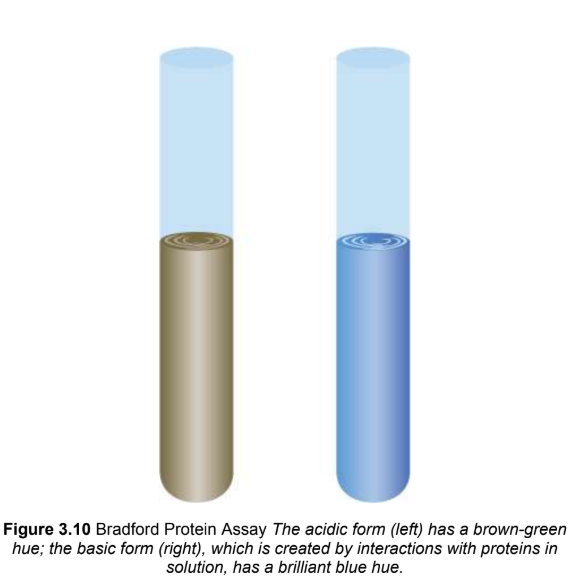MCAT Biochemistry - Nonenzymatic Protein Function and Protein Analysis
1/74
Earn XP
Description and Tags
Name | Mastery | Learn | Test | Matching | Spaced |
|---|
No study sessions yet.
75 Terms
Structural Proteins
support the tissues of the body
tissues made of structural proteins
Tendons, ligaments, cartilage, basement membranes
primary structural proteins
collagen, elastin, keratin, actin, tubulin
motif
a repetitive organization of secondary structural elements; gives structural proetins a fibrous nature
Collagen
characteristic trihelical fiber (three left-handed helices woven together to form a secondary right-handed helix); makes up most of the extracellular matrix of connective tissue; found throughout the body and is important in providing strength and flexibility
osteogenesis imperfecta (brittle bone disease)
collagen cannot form its unique secondary helical structure in the abscence of glycine; replacement of glycine with other amino acids can cause improper folding of the collagen protein and cell death, leading to bone fragility
Elastin
important component of the extracellular matrix of connective tissue; primary role is to stretch and then recoil like a spring, which restores the original shape of the tissue
Keratins
intermediate filament proteins found in epithelial cells; contribute to the mechanical integrity of the cell and also function as regulatory proteins; primary protein that makes up hair and nails
Actin
protein that makes up microfilaments and the thin filaments in myofibrils, most abundant protein in eukaryotic cells, have a positive side and a negative side; polarity allows motor proteins to travel unidirectionally along an actin filament, like a one-way street
Tubulin
protein that makes up microtubules; important for providing structure, chromosome separation in mitosis and meiosis, and intracellular transport with kinesin and dynein; polarity; the negative end of a microtubule is usually located adjacent to the nucleus, whereas the positive end is usually in the periphery of a cell
Motor proteins
molecular motors that convert chemical energy into mechanical work by moving along the cytoskeleton of cells; also display enzymatic activity (ATPase); transient interactions with either actin or microtubules
ATPases
enzymes that break down ATP, esp. to do work
examples of motor proteins
motile cilia and flagella of bacteria and sperm; contraction of the sarcomere in muscle
Myosin
primary motor protein that interacts with actin; the thick filament in a myofibril; can be involved in cellular transport; each subunit has a single head and neck; movement at the neck is responsible for the power stroke of sarcomere contraction
Kinesins
play key roles in aligning chromosomes during metaphase and depolymerizing microtubules during anaphase of mitosis; two heads, one always attached to tubulin; important for vesicle transport towards positive end
ex. neurons - neurotransmitters towards synaptic terminal
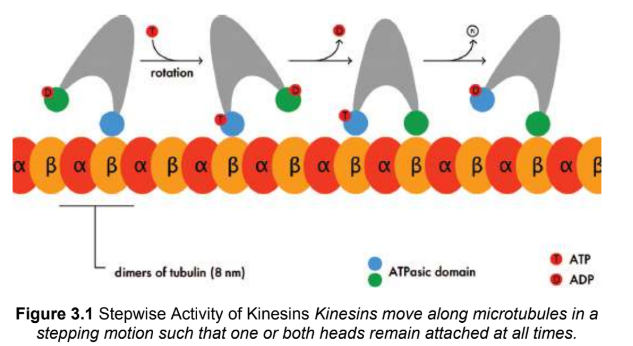
dyneins
involved in the sliding movement of cilia and flagella; important for vesicle transport towards negative end
ex. neurons - vesicles of waste or recycled neurotransmitter back toward the soma
Binding proteins
have stabilizing functions in individual cells and the body; transport or sequester molecules by binding to them
examples of binding proteins
hemoglobin, calcium-binding proteins, DNA-binding proteins (transcription factors)
oxyhemoglobin dissociation curve
haemoglobin’s affinity curve for oxygen; varying affinity depending on the environmental conditions
Cell adhesion molecules (CAMs)
are proteins found on the surface of most cells and aid in binding the cell to the extracellular matrix or other cells
cadherins, integrins, selectins
Cadherins
are a group of glycoproteins that mediate calcium-dependent cell adhesion; similar cell types together (epithelial cells); type-specific (epithelial - E-cadherin; nerve - N-cadherin)
Integrins
group of proteins that all have two membrane-spanning chains called α and β; important in binding to and communicating with extracellular matrix; cellular signalling, cell division, apoptosis, white blood cell migration, stabilization of epithelium on its basement membrane, etc.
ex. integrin αIIbβ3 allows platelets to stick to fibrinogen, a clotting factor, which causes activation of platelets to stabilize the clot
Selectins
bind to carbohydrate molecules that project from other cell surfaces; weakest bonds; expressed on white blood cells and the endothelial cells that line blood vessels; host defense, inflammation, white blood cell migration, etc.
ex. cancer medication target unique CAMs that allow cancer to metastasise
Antibodies/immunoglobulins (Ig)
proteins produced by B-cells that function to neutralize targets in the body, such as toxins and bacteria, and then recruit other cells to help eliminate the threat; Y-shaped proteins that are made up of two identical heavy chains and two identical light chains held together by disulfide & noncovalent interactions
antigen-binding region
tips of the ‘Y’s of antibodies that contains pecific polypeptide sequences that will bind one, and only one, specific antigenic sequence
antigens
target of antibodies; a molecule, moiety, foreign particulate matter, or an allergen, such as pollen, that can bind to a specific antibody or T-cell receptor
constant region
remaining part of the antibody molecule which is involved in recruitment and binding of other cells of the immune system, such as macrophages
Antigen neutralisation
making the pathogen or toxin unable to exert its effect on the body
opsonization
Marking the pathogen for destruction by other white blood cells immediately
agglutinating
Clumping together the antigen and antibody into large insoluble protein complexes that can be phagocytized and digested by macrophages
Biosignaling
a process in which cells receive and act on signals
Ion channels
proteins that create specific pathways for charged molecules
ex. heart disease medication - calcium channel blockers; seizure medication - sodium channel blockers; IBS medication - acetylcholine receptor/cation channel blockers
Facilitated diffusion
a type of passive transport; the diffusion of molecules down a concentration gradient through a pore in the membrane created by a transmembrane protein; used for molecules that are impermeable to the membrane (large, polar, or charged)
ungated channels
have no gates and are therefore unregulated
ex. all cells - potassium channels (net efflux of K+)
voltage-gated channels
gate is regulated by the membrane potential change near the channel
ex. neurons - sodium channels (depolarisation drives conformational change)
ligand-gated channels
the binding of a specific substance or ligand to the channel causes it to open or close
ex. neurons - chloride channel (inhibitory neurotransmitter γ-aminobutyric acid (GABA))
enzyme-linked receptors
display catalytic activity in response to ligand binding; three primary protein domains: a membrane-spanning domain, a ligand-binding domain, and a catalytic domain
ex. Receptor tyrosine kinases (RTK), serine/threonine-specific protein kinases and receptor tyrosine phosphatases
membrane-spanning domain
anchors the receptor in the cell membrane
ligand-binding domain
stimulated by the appropriate ligand and induces a conformational change that activates the catalytic domain
catalytic domain
initiates a second messenger cascade
second messenger cascade
other proteins cause further change in the cell
heterotrimeric G proteins
the binding of a ligand increases the affinity of the receptor for the G protein; the binding of the G protein represents a switch to the active state and affects the intracellular signaling pathway
ex.
Gs stimulates adenylate cyclase, which increases levels of cAMP in the cell
Gi inhibits. adenylate cyclase, which decreases levels of cAMP in the cell
“Mind your p’s and q’s”: Gq activates phospholipase C → cleaves a phospholipid from the membrane → form PIP2 → cleaved into DAG and IP3 → IP3 opens calcium channels in the endoplasmic reticulum → increasing calcium levels in the cell
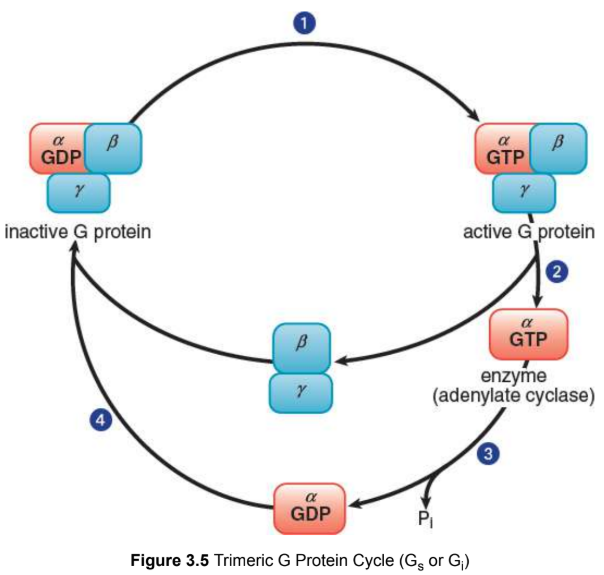
G protein-coupled receptors (GPCR)
a large family of integral membrane proteins involved in signal transduction; characterized by their seven membrane-spanning α-helices
α subunit
binds GDP and is in a complex with the β and γ subunits; can be s or i
adenylate cyclase
an enzyme that catalyzes the conversion of ATP to cAMP, a second messenger involved in signal transduction
homogenization
crushing, grinding, or blending the tissue of interest into an evenly mixed solution
Centrifugation
a mechanical process which involves the use of the centrifugal force to separate particles from a solution according to their size, shape, density, medium viscosity and rotor speed; isolate proteins from much smaller molecules
electrophoresis
subjecting compounds to an electric field, which moves them according to their net charge and size; Negatively charged compounds will migrate toward the positively charged anode, and positively charged compounds will migrate toward the negatively charged cathode; small/more charged/strong electric field molecules move faster; uses electrolytic cell
migration velocity (v)
velocity of electrophretic migration; proportional to the electric field strength, E, and to the net charge on the molecule, z, and is inversely proportional to a frictional coefficient, f
v = Ez/f

Polyacrylamide gel
standard medium for protein electrophoresis; a slightly porous matrix mixture that acts as sieve
Polyacrylamide gel electrophoresis (PAGE)
method for analyzing proteins in their native states; the functional native protein can be recovered from the gel after electrophoresis if unstained; limited by the varying mass-to-charge and mass-to-size ratios of cellular proteins because multiple different proteins may experience the same level of migration
daltons (Da)
an alternative term for molar mass (g/mol)
average molar mass of one amino acid
~ 100 daltons, or 100 g/mol
Sodium dodecyl sulfate (SDS)–polyacrylamide gel electrophoresis (PAGE)
separates proteins on the basis of relative molecular mass alone
SDS
a detergent that disrupts all noncovalent interactions; binds to proteins and creates large chains with net negative charges, thereby neutralizing the protein’s original charge and denaturing the protein
isoelectric point (pI)
the pH at which the protein or amino acid is electrically neutral, with an equal number of positive and negative charges
In isoelectric focusing, a protein stops moving when pH = pI.
zwitterion
a molecule that contains an equal number of positively and negatively charged functional groups
For most amino acids, occurs when the amino group is protonated, the carboxyl group is deprotonated, and any side chain is electrically neutral (except arginine and lysine; occurs when the amino group is deprotonated while the nitrogenous side chain is protonated)
Isoelectric focusing
separating proteins on the basis of isoelectric point (pI); the mixture of proteins is placed in a gel with a pH gradient (acidic gel at the positive anode, basic gel at the negative cathode, and neutral in the middle); electric field is then generated across the gel; positively charged toward the cathode and negatively charged toward the anode, pH = pI → neutral charge → stop moving
Chromatography
a variety of techniques that require the homogenized protein mixture to be fractionated through a porous matrix; the more similar the compound is to its surroundings (by polarity, charge, and so on), the more it will stick to and move slowly through its surroundings; preferred for large amounts
stationary phase/adsorbent.
solid medium in chromatography that does not move
mobile phase
liquid/gas medium in chromatography that moves with the sample
elute
run through the stationary phase
retention time
amount of time a compound spends in the stationary phase
partitioning
separation of the components within the stationary phase due to varying retention times
column chromatography
a column is filled with silica or alumina beads as an adsorbent, and gravity moves the solvent and compounds down the column; size and polarity; can be used to separate and collect other macromolecules besides proteins, such as nucleic acids
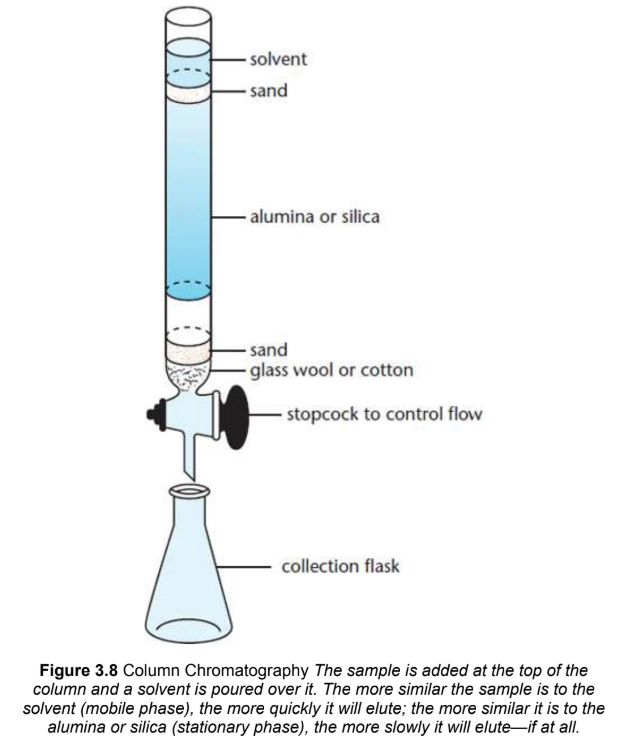
Ion-Exchange Chromatography
the beads in the column are coated with charged substances, so they attract or bind compounds that have an opposite charge; salt gradient is used to elute the charged molecules that have stuck to the column
Size-Exclusion Chromatography
the beads used in the column contain tiny pores that allow small compounds to enter the beads, thus slowing them down; Large compounds can’t fit into the pores, so they will move around them and travel through the column faster
Affinity Chromatography
coating beads with a receptor that binds the protein or a specific antibody to the protein; eluted by washing the column with a free receptor (or target or antibody)
ex. nickel - histidine tags; antibodies/antigens, enzyme substrate analogues
X-ray crystallography
most reliable and common method; An X-ray diffraction pattern is generated in this method, small dots in the diffraction pattern can then be interpreted to determine the protein’s structure
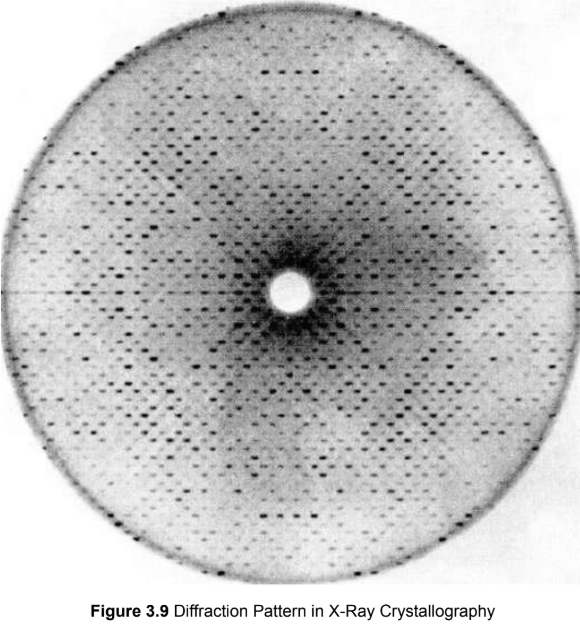
Edman degradation
uses cleavage enzymes to sequence proteins of up to 50 to 70 amino acids; selectively and sequentially removes the N-terminal amino acid of the protein, which can be analyzed via mass spectroscopy
nuclear magnetic resonance (NMR) spectroscopy
spectroscopic technique based on re-orientation of atomic nuclei with non-zero nuclear spins in an external magnetic field
UV spectroscopy
absorption spectroscopy or reflectance spectroscopy in part of the ultraviolet and the full, adjacent visible regions of the electromagnetic spectrum; since proteins have aromatic side chains; used to determine concentration
bicinchoninic acid (BCA) assay
a biochemical assay for determining the total level of protein in a solution. total protein concentration is exhibited by a color change of the sample solution from blue to purple in proportion to protein concentration, which can then be measured using colorimetric techniques
Lowry reagent assay
a biochemical assay for determining the total level of protein in a solution. The total protein concentration is exhibited by a color change of the sample solution in proportion to protein concentration, which can then be measured using colorimetric techniques.
Bradford protein assay
colorimetric protein assay; most common, reliable and simple
